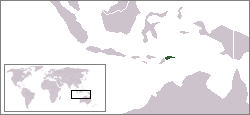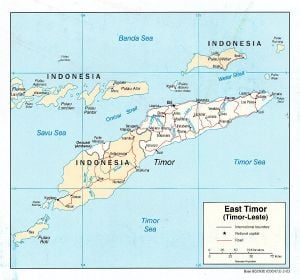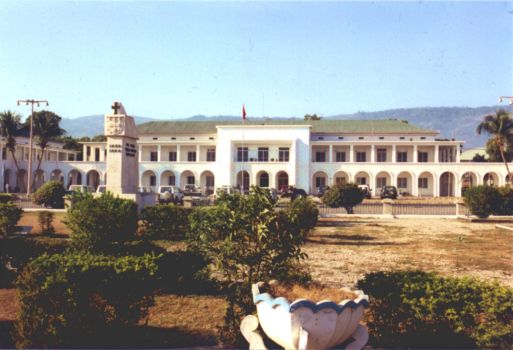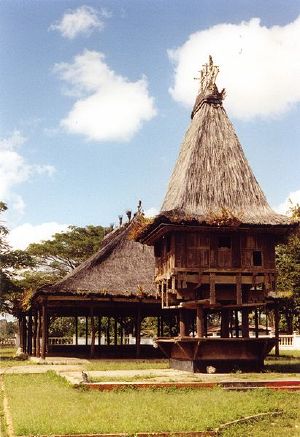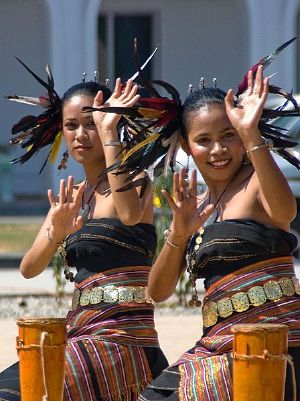East Timor
| Rep√ļblika Demokr√°tika Tim√≥r-Leste[1] (Tetum) Rep√ļblica Democr√°tica de Timor-Leste (Portuguese) Democratic Republic of Timor-Leste |
||||||
|---|---|---|---|---|---|---|
|
||||||
| Motto: "Unidade, Acção, Progresso" (Portuguese) ("Unity, Action, Progress") |
||||||
| Anthem: Pátria |
||||||
| Capital (and largest city) | Dili 8¬į34‚Ä≤S 125¬į34‚Ä≤E | |||||
| Official languages | Tetum and Portuguese1 | |||||
| Working languages | Indonesian and English[2] | |||||
| Demonym | East Timorese | |||||
| Government | Unitary semi-presidential republic[3] | |||||
|  -  | President | José Ramos-Horta | ||||
|  -  | Prime Minister | Xanana Gusmão | ||||
| Independence | from Portugal, Indonesia  | |||||
|  -  | Established | 1702  | ||||
|  -  | Declared | November 28, 1975  | ||||
|  -  | Restored | May 20, 2002  | ||||
| Area | ||||||
|  -  | Total | 14,874 km² (159th) 5,743 sq mi  |
||||
|  -  | Water (%) | negligible | ||||
| Population | ||||||
|  -  | 2022 census | 1,340,434[4]  | ||||
|  -  | Density | 89.7/km² (137th) 232.3/sq mi |
||||
| GDP (PPP) | 2023 estimate | |||||
|  -  | Total | |||||
|  -  | Per capita | |||||
| GDP (nominal) | 2023 estimate | |||||
|  -  | Total | |||||
|  -  | Per capita | |||||
| Gini (2014) | 28.7 [6]  | |||||
| Currency | US$² (USD) |
|||||
| Time zone | (UTC+9) | |||||
| Internet TLD | .tl3 | |||||
| Calling code | [[++670]] | |||||
| 1 | 15 further "national languages" recognised by the Constitution. | |||||
| 2 | Centavo coins also used. | |||||
| 3 | .tp has been phased out. | |||||
East Timor, officially the Democratic Republic of Timor-L'este, is a country in Southeast Asia comprising the eastern half of the island of Timor, the nearby islands of Atauro and Jaco, and Oecussi-Ambeno, an exclave of East Timor on the northwestern side of the island, surrounded by Indonesian West Timor. The small country of 5,376 square miles (14,609 square kilometers) is located about 400 miles (640km) northwest of Darwin, Australia.
Despite its natural resources, East Timor has the lowest per capita income in the world (US$400 per annum). The unemployment rate was estimated at 50 percent in 2001. About 42 percent of the East Timorese live below the poverty line. Between 1999 and 2002, East Timor received $2.2 billion in foreign aid.
A colony of Portugal until 1974, with the Philippines, East Timor is one of only two predominantly Roman Catholic countries in Asia. During a period of occupation by Indonesia, the Catholic Church featured in East Timorese resistance to foreign rule. Ownership of oil resources is one issue yet to be resolved.
Geography
The highest point of East Timor is Mount Ramelau (also known as Mount Tatamailau) at 9,721 ft (2,963 meters]).
The climate is tropical, generally hot and humid, and is characterized by distinct rainy and dry seasons. The capital, largest city, and main port is Dili, and the second-largest city is the eastern town of Baucau. Dili has the only functioning international airport; airstrips in Baucau and Oecusse are used for domestic flights. Dili's airport runway is unable to accommodate large aircraft.
Natural resources include gold, petroleum, natural gas, manganese, and marble. Natural hazards include floods and landslides, earthquakes, tsunamis, and tropical cyclones. Widespread use of slash-and-burn agriculture has led to deforestation and soil erosion.
History
Australoid people who populated New Guinea and Australia arrived in Timor about forty thousand years ago. Around 3000 B.C.E., a second migration brought Melanesians, who later colonized the islands of the Pacific Ocean. Lastly, proto-Malays arrived from southern China and northern Indochina. The country's mountainous terrain resulted in these groups remaining separate, and explains the linguistic diversity in East Timor today.
Timor was incorporated into Chinese and Indian trading networks of the fourteenth century as an exporter of aromatic sandalwood, slaves, honey, and wax. The island had a number of small chiefdoms in the early sixteenth century, including the Wehale Kingdom in central Timor, with its capital at Laran, West Timor, with which the Tetum, Bunaq, and Kemak ethnic groups were aligned.
The Portuguese were the first Europeans to arrive in the sixteenth century. They established outposts in Timor and in some surrounding islands, which were lost to Dutch control by the middle of the seventeenth century. The area became a Portuguese colony in 1702. The Netherlands were formally given West Timor in 1859 through the Treaty of Lisbon. The Hague Treaty of 1916 established what became the international boundary between East Timor and Indonesia.
In late 1941, Portuguese Timor was briefly occupied by Dutch and Australian troops, fighting the Empire of Japan. When the Japanese landed and drove the small Australian force out of Dili, the mountainous interior became the scene of a guerrilla campaign, known as the Battle of Timor from 1942-1943, waged by Allied forces and Timorese volunteers against the Japanese. The struggle resulted in the deaths of between 40,000 and 70,000 Timorese. Portuguese control was reinstated after the end of the war.
In 1974, Portugal abandoned East Timor, which declared itself independent on November 28, 1975. Indonesian forces invaded nine days later. Indonesia alleged that the East Timorese Fretilin party, which received support from the People's Republic of China, was communist. Fearing a Communist domino effect in Southeast Asia, the United States and Australia did not object to the pro-Western Indonesian government's actions. The territory was declared the 27th province of Indonesia in July 1976 as "Timor Timur." The East Timorese guerrilla force, Falintil, fought a campaign against the Indonesian forces from 1975 to 1999.
Indonesian rule was marked by violence, such as the Dili massacre, in which about 250 youngsters were killed at the Santa Cruz Cemetery in on November 12, 1991, and the Liquiçá Church Massacre, in which pro-Indonesian militia killed 200 in April, 1999. Attacks on civilian populations were given only passing notice in the Western press. Death tolls reported during the occupation varied from 60,000 to 200,000.
Following a United Nations sponsored agreement between Indonesia, Portugal, and the United States, the East Timorese voted for full independence in a referendum on August 30, 1999. But violent clashes broke out soon afterward, so a peacekeeping force (INTERFET, led by Australia) intervened. Sporadic armed raids continued from across the border. As these raids were repelled, the militias dispersed and INTERFET was replaced by a UN force.
Portugal recognized independence on May 20, 2002, and East Timor joined the UN on September 27 of that year.
In 1996, Bishop Carlos Filipe Ximenes Belo and José Ramos-Horta, two leading East Timorese activists for peace and independence, received the Nobel Peace Prize. But in April, 2006, a rally in support of 600 dismissed East Timorese soldiers turned into rioting. Five people were killed and over twenty thousand fled their homes. Fierce fighting between pro-government troops and disaffected Falintil troops broke out in May. Contributing to the unrest were the perception of the unfair distribution of oil funds and the poor organization of the Timorese army and police. Prime Minister Mari Alkatiri called the outbreak of violence a "coup" and welcomed offers of foreign military help. Australia, Malaysia, New Zealand, and Portugal sent troops. On June 21, 2006, President Xanana Gusmao asked Prime Minister Mari Alkatiri to step down. Jose Ramos Horta was appointed as his successor on July 8, 2006.
In April 2007, Gusmão declined another presidential term. In the build-up to the April 2007 presidential elections, there were renewed outbreaks of violence in February and March 2007. José Ramos-Horta was inaugurated as President on May 20, 2007 following his election win in the second round. Gusmão was sworn in as Prime Minister on August 8, 2007. President Ramos-Horta was critically injured in an assassination attempt on February 11, 2008 in a failed coup apparently perpetrated by a renegade soldier who died in the attack. Prime Minister Gusmão also faced gunfire separately but escaped unharmed. The Australian government immediately sent reinforcements to East Timor to keep order.
In February 2008, Ramos-Horta was critically injured in an attempted assassination; Prime Minister Gusm√£o also faced gunfire separately but escaped unharmed. Australian reinforcements were immediately sent to help keep order. In March 2011, the UN handed over operational control of the police force to the East Timor authorities. The United Nations ended its peacekeeping mission on December 31, 2012.
Francisco Guterres of the centre-left Fretilin party became president in May 2017. The leader of Fretilin, Mari Alkatiri, formed a coalition government after the July 2017 parliamentary election. This government soon fell, leading to a second general election in May 2018. In June 2018, former president and independence fighter, Taur Matan Ruak, became the new prime minister. José Ramos-Horta again became president on May 20, 2022 after winning the April 2022 presidential election runoff against Francisco Guterres.
Politics
The head of state of the East Timorese Republic is the president, who is elected for a five-year term. Upon election, the president appoints the leader of the majority party or majority coalition. As the head of government, the prime minister presides over the Council of State, or Cabinet.
The unicameral Timorese parliament is the National Parliament of East Timor or Parlamento Nacional, whose members are elected to a five-year term. The number of seats can vary from a minimum of 52 to a maximum of 65, though currently it has 88 members (in 2006). The East Timorese constitution was modeled on that of Portugal.
Economy
The economy of East Timor is a market economy, although it is dependent upon the export of a few commodities and has a large public sector. Internally, market operations are limited by widespread poverty. The country uses the United States dollar, producing its own coins to facilitate smaller transactions. The economy is generally open to foreign investment, although a prohibition on foreigners owning land means many require a local partner in the country.‚Ää Competition is limited by the small size of the economy, rather than any government barriers. There are far more imports than exports, and prices for goods are often higher than in nearby countries. Inflation is strongly affected by government spending.
Timor was best known for its sandalwood. In late 1999, Indonesian troops and anti-independence militias destroyed about 70 percent of the economic infrastructure, and 260,000 people fled west. The United Nations led a massive international program over the next three years, staffed by civilian advisers, 5,000 peacekeepers, and 1,300 police officers, to rebuild both urban and rural areas.
Agricultural products include coffee, rice, corn, cassava, sweet potatoes, soybeans, cabbage, mangoes, bananas, and vanilla. With international guidance, much of East Timor's agriculture sector was converted from subsistence crops including cassava, cowpeas, and sweet potatoes to cash crops like coffee and coconuts to create an export-oriented economy. This effort failed due to low global market prices.
Today, the country faces challenges in rebuilding infrastructure, strengthening the civil administration, and generating jobs for young people.
The Timor Gap and oil
The Portuguese colonial administration granted a concession to Oceanic Exploration Corporation, (OCEX.OB) of Denver, Colorado, to develop the petroleum deposits of the Timor Sea. Before development could begin the Indonesians invaded.
The Timor Gap Treaty, in 1989, divided Timor Sea petroleum resources between Indonesia and Australia. This established guidelines for joint exploitation of seabed resources in the area of the "gap" left by then-Portuguese Timor in the maritime boundary agreed between the two countries in 1972. Revenues from the "joint" area were to be divided equally. Woodside Petroleum and ConocoPhillips began development of some resources in the Timor Gap on behalf of the two governments in 1992.
East Timor inherited no permanent maritime boundaries when it attained independence, repudiating the Timor Gap Treaty as illegal. A provisional agreement (the Timor Sea Treaty, signed when East Timor became independent), defined a Joint Petroleum Development Area, and awarded 90 percent of revenues from existing projects in that area to East Timor and 10 percent to Australia. The first significant new development in the development area since independence is the largest petroleum resource in the Timor Sea, the Greater Sunrise gas field. Only 20 percent of the field lies within the joint area and the rest in waters not subject to the treaty (though claimed by both countries). The initial, temporary agreement gave 82 percent of revenues to Australia and only 18 percent to East Timor.
The Government of East Timor has sought to negotiate a definite boundary with Australia at the halfway line between the countries, in accordance with the United Nations Convention on the Law of the Sea. Australia preferred to establish the boundary at the end of the wide Australian continental shelf, as agreed with Indonesia in 1972 and 1991. Normally a dispute such as this could be referred to the International Court of Justice or the International Tribunal for the Law of the Sea for an impartial decision, but the Australian government had withdrawn itself from these international jurisdictions (solely on matters relating to maritime boundaries) shortly before Timorese independence.
Nevertheless, under public and diplomatic pressure the Australian government offered instead a last-minute concession on Greater Sunrise gas field royalties alone.
In July, 2005, an agreement was signed under which both countries would set aside the dispute over the maritime boundary, and East Timor would receive 50 percent of the revenues (estimated at about US$20 billion over the lifetime of the project) from the Greater Sunrise development. Other developments within waters claimed by East Timor but outside the joint development zone continue to be exploited unilaterally by Australia, however.
The returns from the development of oil and gas resources in 2006 began to supplement government revenues above expectations - the result of high petroleum prices - but did little to create jobs, because the gas is piped to Australia for refining and processing.
Demographics
The population of East Timor has grown rapidly in recent years because of one of the highest birthrates in the world, as well as the return of refugees since independence in 1975. The population is concentrated around the capital city Dili.
Most Timorese are of mixed Malayo-Polynesian and Melanesian/Papuan descent. The largest Malayo-Polynesian ethnic groups are the Tetun, primarily on the north coast and around Dili; the Mambae, in the central mountains; the Tukudede, in the area around Maubara and Liquiçá; the Galoli, between the tribes of Mambae and Makasae; the Kemak in north-central Timor island; and the Baikeno, around Pante Macassar. The main tribes of Papuan origin include the Bunak, in the central interior; the Fataluku, in the east near Lospalos; and the Makasae, toward the eastern end of the island.
There is a smaller population of people of mixed Timorese and Portuguese origin, known in Portuguese as Mestiço. The best-known East Timorese Mestiço's are Xanana Gusmão, the resistance fighter and now president of East Timor, and Prime Minister José Ramos Horta. Mário Viegas Carrascalão, Indonesia's appointed governor between 1987 and 1992, was also Mestiço.
Upon independence, East Timor became one of only two predominantly Roman Catholic Christian countries in Asia (the other being the Philippines). A recent survey estimates that nearly 98 percent of the population are Roman Catholic, though local animist traditions persist. One percent are Muslim and one percent are Protestant. Smaller Hindu, Buddhist, and traditional animist minorities make up the remainder.
Church membership grew considerably under Indonesian rule, as Indonesia's state ideology "Pancasila Indonesia," which requires all citizens to believe in God, did not recognize traditional beliefs. Moreover, as a deep-rooted local institution, the Church not only symbolized East Timor's difference to Muslim Indonesia but played a significant role in the resistance movement, as personified by Bishop Carlos Filipe Ximenes Belo, the 1996 Nobel Peace Prize laureate. Historians note the struggle was not about religion. The Church's role has been acknowledged in the East Timorese constitution, but East Timor is secular and guarantees freedom of religion.
East Timor's two official languages are Portuguese and Tetum, a local Austronesian language. Tetum, known as Tetun-Dili, grew out of the dialect favored by the colonizers at Dili. There are also a variety of non-official dialects known as Tetun-Terik. Indonesian and English are defined as working languages. Another 15 indigenous languages are spoken.
Culture
The culture of East Timor reflects numerous influences, including Portuguese, Roman Catholic, and Malay, on the indigenous Austronesian and Melanesian cultures of Timor. Timorese legend holds that a giant crocodile was transformed into the island of Timor, or Crocodile Island, as it is often called. East Timor now has public holidays that commemorate historic events in the liberation struggle, as well as those associated with Catholic Christianity, and the Feast of the Crocodile on May 3.
Community life is centered around sacred houses (uma lulik (sacred houses) in Tetum, and lee teinu (houses with legs) in Fataluku), physical structures which serve as a representative symbol and identifier for each community. The architectural style of these houses varies between different parts of the country. The house as a concept extends beyond the physical object to the surrounding community. Kinship systems exist within and between houses.
Easily the most famous East Timorese author, the president, Xanana Gusm√£o, wrote two books during the struggle for independence. Also a poet and painter, he produced works describing the culture, values, and skills of the Timorese people. There is a strong oral tradition of poetry among the East Timorese.
East Timor's music reflects its history under the control of both Portugal and Indonesia, who have imported music like gamelan and fado. The most widespread form of native folk music was the likurai dance, traditionally performed by women to welcome men home from war. A modern version of the dance is used by women in courtship.
East Timorese popular musicians include the band Dili All Stars and Lahane, both of whom were associated with the independence movement, as well as Teo Batiste Ximenes, who grew up in Australia and uses folk rhythms from his homeland in his music. Refugee camps in Portugal mixed together East Timorese music with styles from other Portuguese colonies like Angola and Mozambique. The guitar is widely played there, with similar native kinds of string instruments. Foreign influences also include popular styles of music like rock and roll, hip hop, and reggae.
Also still practiced is the weaving of traditional scarves or tais.
Notes
- ‚ÜĎ Name used in the constitution (Konstituisaun Rep√ļblika Demokr√°tika Tim√≥r-Leste Retrieved March 26, 2024.)
- ‚ÜĎ East Timor Country profile BBC News. Retrieved March 26, 2024.
- ‚ÜĎ Dennis Shoesmith, Timor-Leste: Divided Leadership in a Semi-Presidential System Asian Survey 43(2) (2003):231‚Äď252. Retrieved March 26, 2024.
- ‚ÜĎ Timor-Leste Population and Housing Census 2022 Preliminary Results UNFPA Timor-Leste. Retrieved March 26, 2024.
- ‚ÜĎ 5.0 5.1 5.2 5.3 World Economic Outlook Database, October 2023 International Monetary Fund. Retrieved March 26, 2024.
- ‚ÜĎ CIA, Gini Index coefficient - Timor-Leste The World Factbook. Retrieved March 26, 2024.
ReferencesISBN links support NWE through referral fees
- Durand, Frédéric. East Timor: A Country at the Crossroads of Asia and the Pacific, a Geo-Historical Atlas. Chiang Mai: Silkworm Books, 2006. ISBN 9749575989
- Durand, Frédéric. History of Timor Leste. Chiang Mai: Silkworm Books, 2016. ISBN 978-6162151248
- Kingsbury, Damien, and Michael Leach, (eds.). East Timor: Beyond Independence. Clayton, Vic: Monash University Press, 2007. ISBN 978-1876924492
- Leach, Michael, and Damien Kingsbury (eds.). The Politics of Timor-Leste: Democratic Consolidation After Intervention. Ithaca, NY: Cornell University, 2013. ISBN 978-0877277897
- Molnar, Andrea Katalin. Timor Leste: Politics, History, and Culture. New York: Routledge, 2010. ISBN 978-0415778862
- Taylor, John G. East Timor: The Price of Freedom. Annandale: Pluto Press, 1999. ISBN 978-1856498401
External links
All links retrieved March 26, 2024.
- Timor Leste The World Factbook
- Timor-Leste US Department of State
- East Timor Country Profile BBC
- Timor-Leste and Indonesia on the World-Wide Web ETAN
- East Timor Institute for Reconstruction Monitoring and Analysis (La'o Hamutuk)
| Countries and territories of Oceania | |
| Australia : Australia · Norfolk Island | |
| Melanesia : East Timor · Fiji · Maluku Islands & Western New Guinea (part of Indonesia) · New Caledonia · Papua New Guinea · Solomon Islands · Vanuatu | |
| Micronesia : Guam · Kiribati · Marshall Islands · Northern Mariana Islands · Federated States of Micronesia · Nauru · Palau · Wake Island | |
| Polynesia : American Samoa · Cook Islands · French Polynesia · Hawaii · New Zealand · Niue · Pitcairn Islands · Samoa · Tokelau · Tonga · Tuvalu · Wallis and Futuna | |
Credits
New World Encyclopedia writers and editors rewrote and completed the Wikipedia article in accordance with New World Encyclopedia standards. This article abides by terms of the Creative Commons CC-by-sa 3.0 License (CC-by-sa), which may be used and disseminated with proper attribution. Credit is due under the terms of this license that can reference both the New World Encyclopedia contributors and the selfless volunteer contributors of the Wikimedia Foundation. To cite this article click here for a list of acceptable citing formats.The history of earlier contributions by wikipedians is accessible to researchers here:
The history of this article since it was imported to New World Encyclopedia:
Note: Some restrictions may apply to use of individual images which are separately licensed.


